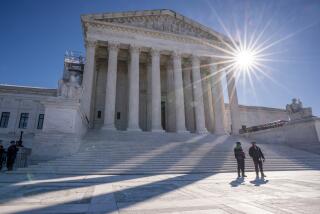High Court’s Crime Offensive: In the End Who Will Be Hurt?
- Share via
The Supreme Court has always made decisions under the influence of its members’ views on the social needs and issues of the times. The current conservative court is no exception--nor should it be.
Its newest members were appointed by two Republican presidents who were elected by overwhelming margins. To voters it has hardly been a secret that Supreme Court vacancies would occur on Ronald Reagan’s and George Bush’s watch and that they would be filled by nominees of like political mind. Not surprisingly, recent polls show that the public is generally supportive of this court. Yet whether one applauds or deplores the court’s effort to strike a hard line on crime, a recent series of decisions is troubling.
Historically, courts have had to balance the need for social order and justice with the protection of individual rights. It’s not easy, and the question about this court is whether it is indeed striking a proper balance.
THE PROGRAM: If anything with this court, what you see is what you get. William H. Rehnquist, first named to the court in 1971, was a known judicial quantity in 1986 when he was elevated by President Reagan to chief justice; his high profile on the crime issue this term comes as no shock. For decades he championed a “harmless error” rule that, despite the Fifth Amendment’s explicit prohibition on forced self-incrimination, would prevent automatic acquittal in cases where evidence about coerced confessions was introduced.
Not surprisingly, then, the court this past term ruled exactly this way in Arizona vs. Fulminante. “Reform” of the habeas corpus process is another Rehnquist issue. Whereas Congress failed to limit habeas corpus petitions, Rehnquist, at the urging of prosecutors and victims-rights groups, has now done so in decisions restricting the right of prisoners to petition the court to review convictions in light of new information.
The court also upheld the use of so-called victim-impact statements in death-penalty cases, overturning a recent decision banning them from trials. It permitted jailing with no warrant for up to 48 hours, during which time police can look for probable cause for the arrest. It upheld a Michigan law requiring a life sentence without parole for first-time possession of cocaine, substantially weakening the Eighth Amendment’s prohibition of “cruel and unusual punishment.” The justices permitted police without warrant, or specific suspicion, to “sweep-search” intercity bus passengers for drugs, chipping away at the Fourth Amendment’s prohibition against unreasonable searches and seizures.
Unquestionably, Rehnquist and his new-found majority on the court-- which usually, though not always, includes Justices Antonin Scalia, Sandra Day O’Connor, David Souter and Anthony M. Kennedy--have addressed the crime issue with a frontal attack. In theory there’s nothing wrong with that. What gives pause is the sudden reversals of constitutional precedents--some of long standing. The worry is about the speed of these reversals and about the wisdom of expanding police powers at the expense of individual rights, even in the name of reducing crime, an inarguably laudable cause.
One also has to question whether the court’s decisions will actually increase arrests and convictions, and send more convicted criminals to prison--in short, whether this serial reversal of precedent will really reduce crime.
THE CRITIQUE: The court’s about-faces are not grounded in proven crime-control strategies but on personal beliefs about a link between punishment, or procedural reform, and deterrence. For example, prosecutors and police have long argued that loosening search and seizure rules would produce more convictions. Yet studies raise serious doubts about the assumption that many convictions are “lost” because courts rule that evidence was obtained illegally.
Another worry is over the court’s vague reasoning. In permitting jailing for up to 48 hours without a warrant, for example, Justice O’Connor offered no explanation of why the court settled on 48 hours, not 36 or 72. That question stumped even Justice Scalia. “So far as I can discern,” he wrote, the court “simply decided that . . . it is not so bad for an utterly innocent person to wait 48 hours in jail.”
Still another point of concern is Rehnquist’s remark that 5-to-4 decisions with “spirited” dissents are the ripest precedents for overruling. This is a spurious standard that might someday boomerang on Rehnquist and easily be invoked to justify reversals of this court’s own rulings. Such a standard adds a measure of uncertainty to jurisprudence: It suggests you don’t have to take the result of the game seriously if the score is close!
It’s true that adherence to precedent, as Rehnquist now believes, is “not an inexorable command.” But the high court must be careful when reversing precedent to worry not only about the problem of crime but also about individual rights.
For instance, permitting the introduction of coerced confessions may serve to imprison some alleged criminals; but the rule has acted as a restraint on police. Now the court has, in effect, invited police to take a gamble; they can theoretically try to get a confession, through force or threats of force, on the chance that a judge will find such coercion “harmless error” and allow the case to proceed.
Even if the majority’s motives in implementing an anti-crime agenda are the best, the worry is that the court is too easily casting aside its historic role as the staunchest, and often last, protector of the individual against state power. Unless the court’s direction is modified, its solution to the crime problem could prove tragically worse than the disease.
More to Read
Sign up for Essential California
The most important California stories and recommendations in your inbox every morning.
You may occasionally receive promotional content from the Los Angeles Times.













